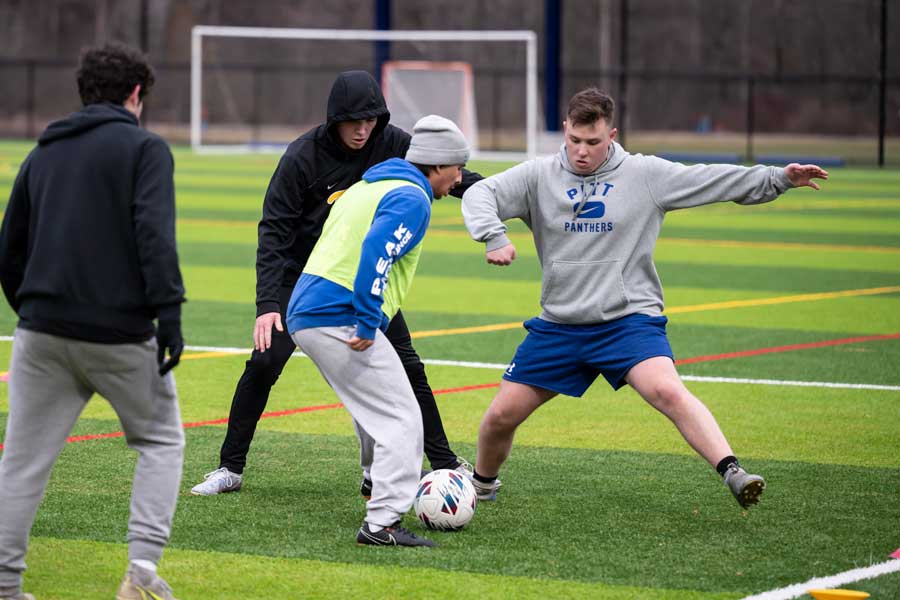
Spring came early this year for athletes at the University of Pittsburgh at Bradford. It’s not just that it was warmer than normal across the Twin Tiers. When it wasn’t actively snowing, the university’s softball, baseball, soccer and lacrosse teams were able to start outdoor practices in February on the university’s artificial turf field installed in November.
Athletic Director Bret Butler said baseball and softball are the first sports reaping the benefit of the new field. Those teams are usually on their spring break trips in Florida most years before fielders can start tracking fly balls in the sky or catching ground balls as they skip across the diamond.
Now, it takes about an hour to plow off the field, Butler said, and then it’s open for business. Soccer athletes from both the men’s and women’s teams can practice in the spring, which was impossible when playing on natural grass that turned to mud under cleats.
And the field will be home to Pitt-Bradford’s newest spring sport, a club men’s lacrosse team that will become a Division III team during the 2024-25 academic year.
Head Men’s Lacrosse Coach Scott Gwyn is training his 17 club players to be his returning, experienced players next year. They’re out on the field at 8 every morning.
Gwyn is on track to recruit more than 10 new players by the end of this academic year, with players coming from as far away as California to attend a recruitment camp he held in the fall.
Gwyn is targeting geographic diversity not just to attract the best players he can, but also to recruit a variety of playing styles, since style of play tends to vary by geography, he said. Pitt-Bradford club players are already having an impact on the future DIII team.
“A lot of recruits are attracted to the newness of the program and the chance to make an impact,” Gwyn said, “but they also just really like our guys.”
“Our guys” being his current club players. “They’re very joyful, and that’s the mixing of the cultures at work.”
The mixing of cultures is more than a metaphor here. Pitt-Bradford players will be playing in the cradle of lacrosse – on land once occupied by the Haudenosaunee nation, also known by the name Iroquois.
The Haudenosaunee are the inventors and original players of lacrosse, and Gwyn and his players have been learning about the game’s importance to the Haudenosaunee from a teammate who is Seneca.
“It’s a sport that has a weight to it,” Gwyn said. “We need to play it in a way that honors its founders.”
The element of historical significance and proximity to the game’s origins was one of the reasons Gwyn wanted to coach at Pitt-Bradford.
One of Gwyn’s lacrosse players, senior Ty Bowen of Salamanca, is teaching others about the game’s roots. “Lacrosse is a unique sport in that it is a lot of traditional beliefs from my culture,” he said. “My teammates … love hearing about how much the game means to me.”
Head Women’s Soccer Coach Lorenzo Rodriguez said, “The team is excited to play on a brand-new field as well as recruits. They’re excited about being able to play at home under the lights, and now we don’t have to plan around the sun’s schedule.”
In addition to laying artificial turf, the university has installed floodlights that have greatly expanded the hours the field can be used.
It’s a game changer, the soccer coaches explained. Before artificial turf and lights, teams could only practice during daylight hours, which also happens to be when athletes have classes. Nate Whitehurst, the men’s soccer coach, said his starting lineup couldn’t practice together last year.
Rodriguez experienced similar problems. “Not being able to practice together takes away from team chemistry,” he said. “The artificial turf is giving us a real home to practice and compete on and will provide a new sense of camaraderie for players.”
Even when the sun was shining, soccer teams often had to abandon campus altogether as the wear and tear of practices and games on natural grass led to muddy playing conditions that made injuries more likely. Panther soccer teams would have to change to a less aggressive playing style partway through the season to account for the muddy field.
Or the university would rent Bradford Area High School’s artificial turf field nearly a mile from the Kessel Athletic Complex. Panther practices were scheduled when high school football and girls’ and boys’ soccer teams weren’t playing, which meant a lot of early mornings and late nights for the Panthers.
While the upgrades will have a significant impact on Panther athletics (including the addition of women’s lacrosse a year behind the men’s team), there’s more to come. A small building at the field will provide an elevated press box, public rest rooms and locker rooms.
“Once the press box and locker rooms are built, we’re going to have one of the best facilities in the Allegheny Mountain Collegiate Conference,” Whitehurst said.